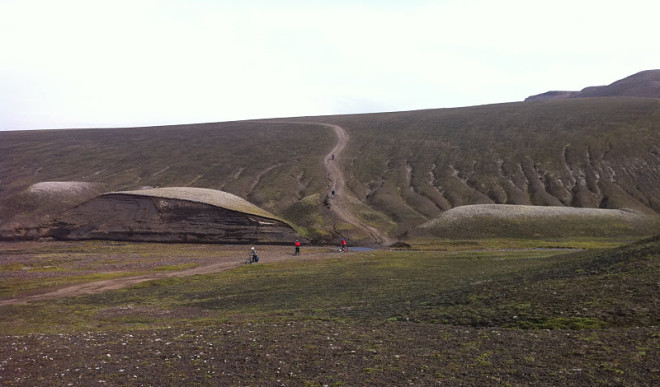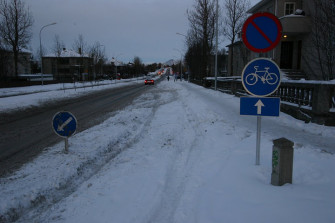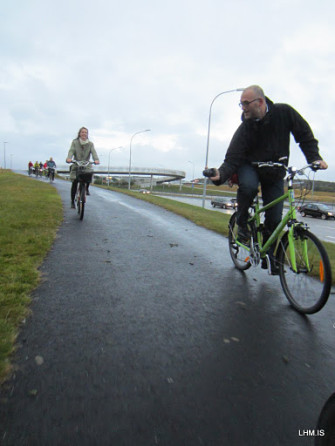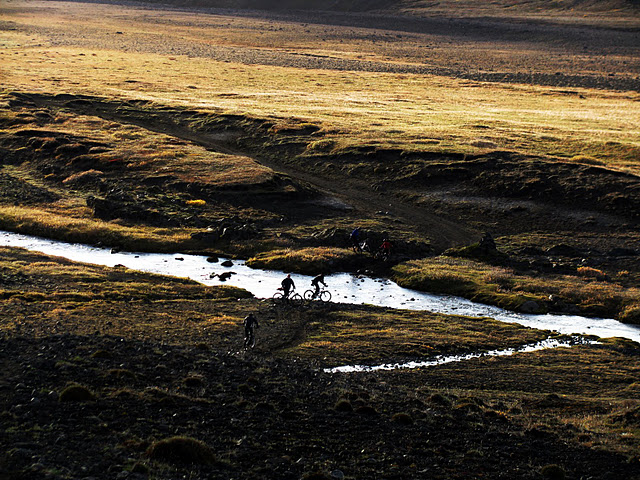
Member of the Month: Iceland
ECF has associate members all over the world. From Turkey to America, and Bulgaria to the United Kingdom. Yet often when we think cycling, our thoughts drift to the Netherlands, or Denmark. We forget that cycling is going global. The last decade has seen an explosion in cycling from even the most car-centric cities. If the big apple is going to install a bike share scheme, then surely "times are a changing". This month, we've decided to investigate Iceland. The land of fire and ice is making its mark on the cycling scene. In an interview with Morten Lange, board member of the Icelandic Cyclists' Federation, ECF was briefed on cycling in one of Europe's remotest and little known nations.
The "Holy Grail" when it comes to measuring cycling is modal share. Yet Iceland for the moment doesn't really have any reliable figures to go by. Up until recently the authorities didn't really have much interest in measuring cycling. Thankfully, things are changing
"Rough figures have been measured in Autumn, and it appears we have about a 3% modal share"
"Rough figures have been measured in Autumn, and it appears we have about a 3% modal share", says Lange, "and we expect this figure to be even higher in the Summer time."
What kind of Infrastructure?
I was curious to whether or not the Iceland opts for the Dutch style cycle paths or whether cyclists had to brave it and be part of the traffic flow.
"Outside the capital there is virtually nothing in the way of bicycling facilities", notes Lange but he tells me that there are more than 100 kms of segregated and multi-use paths in Reykjavik and half that in the neighbouring municipalities. These paths are quite typical in Scandinavia in which pedestrians and cyclists share the path. Just recently the capital has begun installing a cyclist only segregated path. So far, about 7kms have been built and it’s a sign that cycling is gaining traction as a mode of transport for commuting.
Lange tells me that they are pushing for more facilities, especially as an alternative to the trunk roads between the major suburbs. There is a very distinct lack of facilities when exiting the capital with little connectivity and no direct routes etc. but Reykjavik city has a new cycling strategy, and a design manual which will hopefully bring about change.
The vehicular vs. segregated debate is also one that divides cyclists in Iceland.
"We also have this debate that you see regularly in the Anglophone cycling world and we try to find some middle ground", says Lange.
"We try to say that vehicular cycling can be a great tool, but it is not the way to promote cycling. There will always be timid people who will be afraid of cars. Still, for many cyclists, vehicular cycling is a good tool, so that you don’t have to wait for the infrastructure. It’s a great way to reclaim the streets"
The Icelandic Cyclists' Federation had a British expert help train instructors to run a bicycle program known as Hjólafærni (bike-ability). The dissemination of this technique has helped people on bikes gain confidence on the roads despite gaps in infrastructure.But there’s little doubt that improved infrastructure is the more suitable long-term solution
Ironically, while they had no money for cycling, they spent big on paths for riding horses
Horses or Bikes?
The political situation was by no means favorable towards building cycling infrastructure a few decades ago. Lange tells me that until recently, the national body responsible for public roads was not legally allowed to spend money on cycling infrastructure. It was up to the municipalities.
 Ironically, while they had no money for cycling, they spent big on paths for riding horses. "The Icelandic horses are somewhat of a national symbol here", quips Lange "and there are some strong connections with high ranking politicians that ride horses." It must also be said that the horses do provide an big economic boost for Icelandic tourism.
Ironically, while they had no money for cycling, they spent big on paths for riding horses. "The Icelandic horses are somewhat of a national symbol here", quips Lange "and there are some strong connections with high ranking politicians that ride horses." It must also be said that the horses do provide an big economic boost for Icelandic tourism.
Thankfully times are changing. There's a political ground swell for more sustainable transport as Iceland goes green. A report published by the Ministry for the Environment labeled Cycling as a cost effective way to combat climate change. This report has had quite an impact on government policy, and this is seeping in despite slow movement.
But the catalyst for politicians getting behind pedal power is economics. The financial crisis hit Iceland hard, with the Kronuer losing 50% of its value so imported goods are becoming far more expensive for many people to buy, especially when it comes to cars and petrol. But does this increase in political interest translate into much action?
"There is a will… but the convictions [of politicians] aren't strong enough", Lange explains.
"We get impatient about progress. There has been major news in terms of financing of infrastructure. Money is now being moved from multi-level junctions to public transport and probably to some extent to cycling. The ministers and politicians don’t quite seem to agree whether or not cycling will get some of the car infrastructure and money"
A glass of wine and a dutch bicycle? Cycling Culture in Iceland
Per capita car ownership in Iceland is among the highest in the world at roughly 522 vehicles per 1000 resident.
Per capita car ownership in Reykjavik is among the highest in the world at roughly 680 vehicles per 1000 residents. Lange tells me quite dryly, “People sometime use their car instead of an overcoat. They drive very short distances."
The upside of this is of course that the vast majority of trips are very short and so there is a great potential for more cycling. But I was really interested in what kind of cyclists take to the roads in Iceland. Do we see more of the slow and sexy riders that Copenhagenize envisages, or is it all about Lycra crad men claiming the roads?
"Many people are “hardcore” cyclists," explains Lange. "They use special clothing for cycling. They tend to cycle ten kilometers or longer to work and they're inclined to cycle for recreation. However cyclists that cycle in normal clothes seems to be the fastest growing segment."
It would even appear that the cycle chic culture has made its way to Iceland.
One of the challenges in developing a cycling culture in Iceland is not so much the cold, but rather the erratic weather. Wind is more of a challenge than the snow. The country can get really strong storms 15 times a year and at times you really have to be dedicated to go out cycling.
That being said, the cycle to work campaign in which the Icelandic Cyclists' Federation is a partner, has made a huge difference, and it’s one that Lange is very proud of.
To put these figures in perspective, it would be the same as if 1.8 million Brits took part in a ride to work campaign.
The campaign began in 2003 and saw 11,000 participants take part in the three week event this spring, equating to 3% of the island's populations. To put these figures in perspective, it would be the same as 1.8 million Brits taking part in a ride to work campaign.
One of the real strengths in having this ride to work campaign was its media impact. Virtually every media outlet on the island knows about the event and it has cast cycling in a much more positive light. Cycling moved from being a sport to something that you can do to just get from A to B.
The issues of helmets does pop up in the Icelandic papers, and only last week, there was a news item about a cyclist that got hit by a car and how “his helmet saved him” without providing any evidence to how or why. Fierce policy debates in recent years have raged in Iceland over helmets. But prior to 2005, very few people had thought about it. Lange's message was that he's not at all against helmets; he's just "against mandatory laws and dangerous, misleading helmet promotion". As it currently stands, helmets are mandatory for children under 15 in Iceland.
Some Icelandic Wisdom for Global cycling Advocacy
Morten Lange was keen to share some messages with the cycling world.
"It needs a lot of patience" he says, "And Cooperation. We have had success in cooperating with environmental groups, public health groups, and groups that are interested in the urban environment".
Building informal alliances makes for a broader dissemination of the cycling expertise is also important as is getting residents on board. In Reykjavik, many residents like the idea of taming traffic volumes and speed but have a “not in my back yard” attitude. Recently, Lange believes the mindset is changing and they now understand that we need to view this in a larger picture
Paying the real cost for parking should also be high on the agenda.
"Almost nobody pays for parking their cars in Iceland, bar those travelling to the centre. Make sure you point out the economic injustice of subsidies for cars. It's not fair for employers to pay for the running of cars, and not do similar things for public transport or cycling"
As it currently stands in Iceland, there are now three companies and two government ministries that are offering subsidies for those employees that only occasionally use a parking spot. .
Morten's final message for me was to come to Iceland and to be honest, I'm very tempted. Judging by the scenery, it's a cycling tourist's haven. Long open stretches, and very few people or cars.
"The colours in the rocks and flora here are fascinating. There’s this very, very green thick moss on top of the lava fields. And when you walk gently on it the rocks beneath shift", Lange tells me.
"And if you’re lucky, there’s fog drifting over the mountains. It’s a little... well supernatural".
As long as the Eyjafjallajokul volcano holds back, I'll be booking tickets soon.
The video which shows the remake of the famous Muenster poster
[[{"type":"media","view_mode":"media_large","fid":"481","attributes":{"class":"media-image","typeof":"foaf:Image","height":"300","width":"400","style":""}}]]
Myndum borg! (Picture a City ...) from Gísli Marteinn Baldursson on Vimeo.
About the Author
Julian Ferguson is the Communications Officer for the European Cyclists’ Federation. Originally hailing from Australia and a keen bicycle advocate, he plans one day to ride his bicycle from Brussels to Melbourne
About the Interviewee
Coming from a car-free household, Morten Lange has been a more or less avid cyclist since 1971. At the age of seven, his parents took him on a two week bicycle trip across the Finnmark plain in far northern Norway ( Sapmi ) where nobody had cycled before, apparently. Lange joined the board of the Icelandic Cyclists' Federation ( LHM : Landssamtök hjólreiðamanna) in 2001, some six years after moving to Iceland. During his years as chairman of LHM, 2005-2009, the ties to advocates in other countries were strengthened. Icelanders attended the Velo-city conferences for the first time and LHM joined the European Cyclists' Federation. Lange is currently a member of the board of the LHM.
Contact the author
Recent news!
Upcoming events
Contact Us
Avenue des Arts, 7-8
Postal address: Rue de la Charité, 22
1210 Brussels, Belgium


















